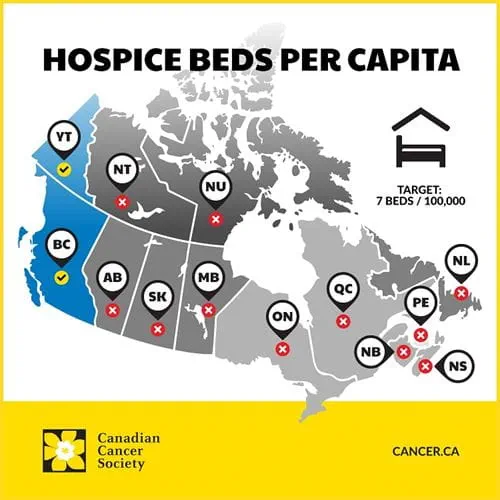
There are few things scarier than hearing you or someone you love has a serious or life-limiting cancer diagnosis.
For someone with a progressive illness like cancer, palliative care can provide comfort, care and control to them live comfortably for as long as possible. It’s an essential service, as many having accessed it can attest to.
A new research report released by the Canadian Cancer Society (CCS) is uncovering the state of palliative care across Canada and has found that many governments are sadly falling short. For example, best practices suggest we should have 7 hospice beds per 100,000 people. However, as of last year Canada only has 3.97 hospice beds per 100,000 people. Only British Columbia and Yukon exceed the 7 beds per 100,000 people threshold.

The report also highlights other gaps in palliative care seen consistently across jurisdictions, including a need for palliative care across more settings than in hospitals to ensure continuity of care, especially in a pandemic, more training for healthcare providers, and culturally safe palliative care including grief and bereavement.
“It’s difficult to understand the true impact of palliative care until you’ve experienced it first-hand for yourself or for a loved one,” says Daniel Nowoselski, Advocacy Manager of Hospice Palliative Care at the Canadian Cancer Society. “It’s a support everyone in Canada deserves, but not everyone gets. We encourage governments to use this report as a learning for how they can better support people living with a life-limiting disease like cancer.
This is the first time data like this has been collected since 2017, and the first time ever that we have a complete count of the number of hospice beds in Canada. The report was created using survey data collected by all provinces and territories, 4 departments of the federal government and 13 community organizations.
To learn more, read the full report. If you want to see better palliative care, take action now at cancer.ca/palliativecare.
Help create a future without cancer
With support from readers like you, we can continue to make a meaningful impact for people affected by cancer.
We are determined to increase survival, stop cancer before it starts, and improve lives. But we can’t do it without you.
If everyone reading this gave just $5, we could achieve our goal this month to fund the most promising research, compassionate support and transformative advocacy. Please give today because every contribution counts. Thank you.
